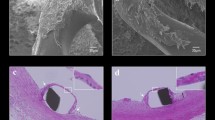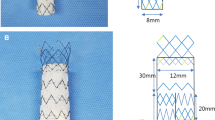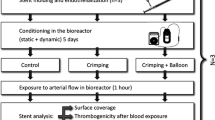Abstract
Purpose: To test the vascular wall response to an expanded polytetrafluoroethylene-covered stent, compared with conventional stenting, up to 6 months after deployment in the vascular district of a swine model.
Methods: Fourteen minipigs underwent implantation of expanded polytetrafluoroethylene-covered stents (CS) and bare stents (BS) in five peripheral arteries. Animals were killed at different time points (from 1 to 180 days). Histopathologic assessment by morphologic and morphometric analysis and by scanning electron microscopy (SEM) were used to assess the incorporation characteristics and re-endothelialization extent of the two types of stents.
Results: A total of 70 stents (14 CS and 14 BS in the renal arteries; 28 CS in the iliac arteries, and 14 CS in the aorta) were implanted. Microscopic examination confirmed the absence of occlusive thrombi in both the CS and BS groups. Microthrombi were observed in 10 of 13 CS (77% of cases) and in four of four BS (100% of cases, p < 0.05). Inflammation was mild in 69% of segments in which a CS was implanted and in 74% of segments in which a BS was implanted (p= NS), while a severe inflammatory reaction was observed in 6% of CS segments and in 8% of BS segments (p= NS). No differences were detected at the long-term analysis between neointimal thickness in CS compared with BS segments (0.46 ± 0.18 mm vs 0.42 ± 0.26 mm at 90 days and 0.36 ± 0.08 mm vs 0.35 ± 0.04 mm at 180 days; p= NS, respectively). At SEM analysis, re-endothelization was evident 15 days after the implant in both CS and BS starting from the stent edges.
Conclusion: CS implantation did not elicit a more severe thrombotic deposition compared with that of BS. A similar inflammatory reaction of the arterial wall was present in the two stent groups 3 and 6 months following the implant. In addition, CS implantation did not stimulate excessive neointimal formation when compared with BS.
Similar content being viewed by others
Author information
Authors and Affiliations
Rights and permissions
About this article
Cite this article
Sangiorgi, G., Arbustini, E., Lanzarini, P. et al. Nonbiodegradable Expanded Polytetrafluoroethylene-Covered Stent Implantation in Porcine Peripheral Arteries: Histologic Evaluation of Vascular Wall Response Compared with Uncoated Stents. Cardiovasc Intervent Radiol 24, 260–270 (2001). https://doi.org/10.1007/s00270-001-1729-4
Published:
Issue Date:
DOI: https://doi.org/10.1007/s00270-001-1729-4




